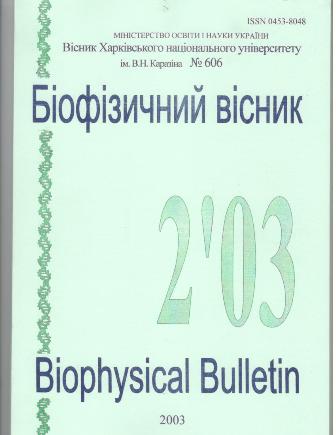Radiation damage annealing in γ-irradiated amino acid crystals
Abstract
In the paper the processes of free radicals (FR) annealing in the γ-irradiated amino acid crystals have been studied by the electron paramagnetic resonance (EPR) method. The mechanism of the radioactive FR destruction based on the diffusion of the fragmentary radioactive vacancies or interstitial fragments is offered. The reaction of FR recombination is the secondary reason of the radioactive destruction of the crystal, a consequence of the radioactive vacancies diffusion or diffusion of the introduced fragments. The air oxygen does not play an essential role during FR destruction in amino acid crystals.
Downloads
References
Nikolov OT, Gatash SV, Serdjuk AD. Ukr. fiz. zhurn. 1980;10:1604-10. (in Russian)
Mihajlov AI, Bol'shakov AI, Lebedev JaS, Gol'danskij VI. FTT. 1972;4:1172-9. (in Russian)
Kajushin LP, L'vov KM, Pulatova MK. Issledovanie paramagnitnyh centrov obluchennyh belkov. M.:Nauka; 1970. 264p. (in Russian)
Gurskaja GV. Struktura aminokislot. M.:Nauka; 1966. 160p. (in Russian)
Komar' IN, Nikolov OT. Majer I. Teoreticheskaja i jeksperimental'naja himija. 1970;6(4):561-6. (in Russian)
Salihov KM. TJeH. 1977;13(6):731-9. (in Russian)
Authors who publish with this journal agree to the following terms:
- Authors retain copyright and grant the journal right of first publication with the work simultaneously licensed under a Creative Commons Attribution License that allows others to share the work with an acknowledgement of the work's authorship and initial publication in this journal.
- Authors are able to enter into separate, additional contractual arrangements for the non-exclusive distribution of the journal's published version of the work (e.g., post it to an institutional repository or publish it in a book), with an acknowledgement of its initial publication in this journal.
- Authors are permitted and encouraged to post their work online (e.g., in institutional repositories or on their website) prior to and during the submission process, as it can lead to productive exchanges, as well as earlier and greater citation of published work (See The Effect of Open Access).





